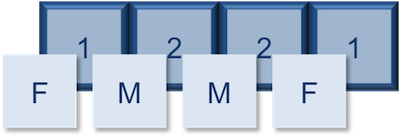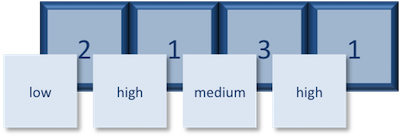Approximate time: 20 min
Learning Objectives
- Become familiar with R syntax
- Understand variables and the assignment operator in R
- Understand the various data types and data structures in R
The R syntax
Now that we know how to talk with R via the script editor or the console, we want to use R for something more than adding numbers. To do this, we need to know more about the R syntax.
Below is an example script highlighting the many different “parts of speech” for R (syntax):
- the comments
#and how they are used to document function and its content - variables and functions
- the assignment operator
<- - the
=for arguments in functions
NOTE: indentation and consistency in spacing is used to improve clarity and legibility
Example script
## DO NOT RUN
# Load libraries
library(Biobase)
library(limma)
library(ggplot2)
# Setup directory variables
baseDir <- getwd()
dataDir <- file.path(baseDir, "data")
metaDir <- file.path(baseDir, "meta")
resultsDir <- file.path(baseDir, "results")
# Load data
meta <- read.delim(file.path(metaDir, '2015-1018_sample_key.csv'), header=T, sep="\t", row.names=1)
Assignment operator
To do useful and interesting things in R, we need to assign values to
variables using the assignment operator, <-. For example, we can use the assignment operator to assign the value of 3 to x by executing:
x <- 3
The assignment operator (<-) assigns values on the right to variables on the left.
In RStudio, typing Alt + - (push Alt at the same time as the - key) will write ` <- ` in a single keystroke.
Variables
A variable is a symbolic name for (or reference to) information. Variables in computer programming are analogous to “buckets”, where information can be maintained and referenced. On the outside of the bucket is a name. When referring to the bucket, we use the name of the bucket, not the data stored in the bucket.
In the example above, we created a variable or a ‘bucket’ called x. Inside we put a value, 3.
Let’s create another variable called y and give it a value of 5.
y <- 5
When assigning a value to an variable, R does not print anything to the console. You can force to print the value by using parentheses or by typing the variable name.
y
You can also view information on the variable by looking in your Environment window in the upper right-hand corner of the RStudio interface.

Now we can reference these buckets by name to perform mathematical operations on the values contained within. What do you get in the console for the following operation:
x + y
Try assigning the results of this operation to another variable called number.
number <- x + y
Exercise
- Try changing the value of the variable
xto 5. What happens tonumber? - Now try changing the value of variable
yto contain the value 10. What do you need to do, to update the variablenumber?
Tips on variable names
Variables can be given almost any name, such as x, current_temperature, or
subject_id. However, there are some rules / suggestions you should keep in mind:
- Avoid names starting with a number (
2xis not valid butx2is) - Keep in mind that R is case sensitive (e.g.,
genome_lengthis different fromGenome_length) - Make your names explicit and not too long.
- Be consistent with the styling of your code (where you put spaces, how you name variable, etc.). In R, two popular style guides are Hadley Wickham’s style guide and Google’s.
- Avoid names of fundamental functions in R (e.g.,
if,else,for, see here for a complete list). In general, even if it’s allowed, it’s best to not use other function names (e.g.,c,T,mean,data) as variable names. When in doubt check the help to see if the name is already in use. - Avoid dots (
.) within a variable name as inmy.dataset. There are many functions in R with dots in their names for historical reasons, but because dots have a special meaning in R (for methods) and other programming languages, it’s best to avoid them. - Use nouns for object names and verbs for function names
Data Types
Variables can contain values of specific types within R. The six data types that R uses include:
"numeric"for any numerical value"character"for text values, denoted by using quotes (“”) around value"integer"for integer numbers (e.g.,2L, theLindicates to R that it’s an integer)"logical"forTRUEandFALSE(the boolean data type)"complex"to represent complex numbers with real and imaginary parts (e.g.,1+4i) and that’s all we’re going to say about them"raw"that we won’t discuss further
The table below provides examples of each of the commonly used data types:
| Data Type | Examples |
|---|---|
| Numeric: | 1, 1.5, 20, pi |
| Character: | “anytext”, “5”, “TRUE” |
| Integer: | 2L, 500L, -17L |
| Logical: | TRUE, FALSE, T, F |
Data Structures
We know that variables are like buckets, and so far we have seen that bucket filled with a single value. Even when number was created, the result of the mathematical operation was a single value. Variables can store more than just a single value, they can store a multitude of different data structures. These include, but are not limited to, vectors (c), factors (factor), matrices (matrix), data frames (data.frame) and lists (list).
Vectors
A vector is the most common and basic data structure in R, and is pretty much the workhorse of R. It’s basically just a collection of values, mainly either numbers,

or characters,

or logical values,

Note that all values in a vector must be of the same data type. If you try to create a vector with more than a single data type, R will try to coerce it into a single data type.
For example, if you were to try to create the following vector:

R will coerce it into:

The analogy for a vector is that your bucket now has different compartments; these compartments in a vector are called elements.
Each element contains a single value, and there is no limit to how many elements you can have. A vector is assigned to a single variable, because regardless of how many elements it contains, in the end it is still a single entity (bucket).
Let’s create a vector of genome lengths and assign it to a variable called glengths.
Each element of this vector contains a single numeric value, and three values will be combined together into a vector using c() (the combine function). All of the values are put within the parentheses and separated with a comma.
glengths <- c(4.6, 3000, 50000)
glengths
Note your environment shows the glengths variable is numeric and tells you the glengths vector starts at element 1 and ends at element 3 (i.e. your vector contains 3 values).
A vector can also contain characters. Create another vector called species with three elements, where each element corresponds with the genome sizes vector (in Mb).
species <- c("ecoli", "human", "corn")
species
Factors
A factor is a special type of vector that is used to store categorical data. Each unique category is referred to as a factor level (i.e. category = level). Factors are built on top of integer vectors such that each factor level is assigned an integer value, creating value-label pairs.

Let’s create a factor vector and explore a bit more. We’ll start by creating a character vector describing three different levels of expression:
expression <- c("low", "high", "medium", "high", "low", "medium", "high")
Now we can convert this character vector into a factor using the factor() function:
expression <- factor(expression)
So, what exactly happened when we applied the factor() function?

The expression vector is categorical, in that all the values in the vector belong to a set of categories; in this case, the categories are low, medium, and high. By turning the expression vector into a factor, the categories are assigned integers alphabetically, with high=1, low=2, medium=3. This in effect assigns the different factor levels. You can view the newly created factor variable and the levels in the Environment window.

Matrix
A matrix in R is a collection of vectors of same length and identical datatype. Vectors can be combined as columns in the matrix or by row, to create a 2-dimensional structure.

Matrices are used commonly as part of the mathematical machinery of statistics. They are usually of numeric datatype and used in computational algorithms to serve as a checkpoint. For example, if input data is not of identical data type (numeric, character, etc.), the matrix() function will throw an error and stop any downstream code execution.
Data Frame
A data.frame is the de facto data structure for most tabular data and what we use for statistics and plotting. A data.frame is similar to a matrix in that it’s a collection of vectors of of the same length and each vector represents a column. However, in a dataframe each vector can be of a different data type (e.g., characters, integers, factors).

A data frame is the most common way of storing data in R, and if used systematically makes data analysis easier.
We can create a dataframe by bringing vectors together to form the columns. We do this using the data.frame() function, and giving the function the different vectors we would like to bind together. This function will only work for vectors of the same length.
df <- data.frame(species, glengths)
Note that you can view your data.frame object by clicking on its name in the Environment window.
Lists
Lists are a data structure in R that can be perhaps a bit daunting at first, but soon become amazingly useful. A list is a data structure that can hold any number of any types of other data structures.

If you have variables of different data structures you wish to combine, you can put all of those into one list object by using the list() function and placing all the items you wish to combine within parentheses:
list1 <- list(species, df, number)
Print out the list to screen to take a look at the components:
list1
[[1]]
[1] "ecoli" "human" "corn"
[[2]]
species glengths
1 ecoli 4.6
2 human 3000.0
3 corn 50000.0
[[3]]
[1] 5
There are three components corresponding to the three different variables we passed in, and what you see is that structure of each is retained.
This lesson has been developed by members of the teaching team at the Harvard Chan Bioinformatics Core (HBC). These are open access materials distributed under the terms of the Creative Commons Attribution license (CC BY 4.0), which permits unrestricted use, distribution, and reproduction in any medium, provided the original author and source are credited.
- The materials used in this lesson were derived from work that is Copyright © Data Carpentry (http://datacarpentry.org/). All Data Carpentry instructional material is made available under the Creative Commons Attribution license (CC BY 4.0).